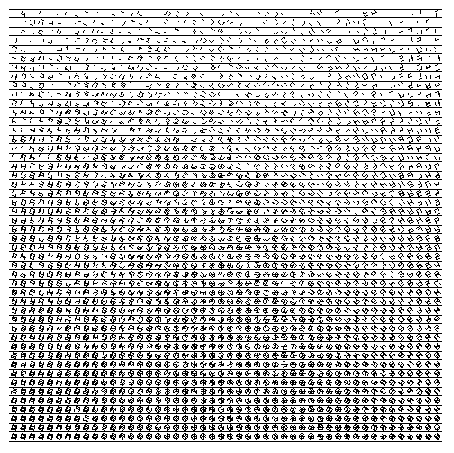
Above, a work by Manfred Mohr. Mohr was born in 1938 in Pforzheim (Germany). He studied lithography at the Ecole des Beaux Arts, in Paris. He turned from traditional painting to the computer in 1969 to realize his artistic interest in Constructivist artforms. He focused his artistic vocabulary and aesthetic expression by working only in black and white, not reverting to a color palette until 1998, using a plotter as output from the computer.
Mohr: The computer became a physical and intellectual extension in the process of creating my art. I write computer algorithms i.e. rules that calculate and then generate the work which could not be realized in any other way. It is not necessarily the system or the logic I want to present in my work, but the visual invention which results from it. My artistic goal is reached, when a finished work can visually dissociate itself from its logical content and convincingly stand as an independent abstract entity.
Mohr's work is on view in a show at bitforms called "Scratch Code," consisting of "computational works work from the 50s through the 70s: plotter drawings, prints, sculptures, film." The above piece (a similar one is in the show) is a direct cop of mines the same territory as Sol LeWitt's Variations of Incomplete Open Cubes, only done with a computer; I like that Mohr is honest enough to say its goal is visual invention rather than depicting some ratiocinative process. Rosalind Krauss convincingly deflated such claims about LeWitt's work in her essay "LeWitt in Progress":The experience of the work goes exactly counter to "the look of thought," particularly if thought is understood as classical expressions of logic. For such expressions, whether diagramatic or symbolic, are precisely about the capacity to abbreviate, to adumbrate, to condense, to be able to imply an expansion with only the first two or three terms, to cover vast arithmetic spaces with a few ellipsis points, to use, in short, the notion of et cetera.
[....]
In Variations of Incomplete Open Cubes....what we find is the "system" of compulsion, of the obsessive's unwavering ritual, with its precision, its neatness, its finicky exactitude, covering over an abyss of irrationality. Update: wording changed based on peevish correction from Mohr: see comments.
If you think that my work is just a copy of Sol Lewitt's Variations
of Incomplete Open Cubes, you are dead wrong.
These series of drawings were done independently and
exhibited in Europe quite some time before Mr. Lewitt exhibited his incomplete open cubes...
History is sometimes distorted by "incomplete open" knowledge.
Manfred Mohr
As we say here in the States, "Lighten up, dude!" The above-linked page says you began working with the incomplete open cube in '73, the same year LeWitt did. So you did it earlier--maybe you should be correcting the university web page documenting your work instead of haranguing bloggers with your stern admonitions.
Besides, no once cares who first started using this particular formal/mathematical idea. Saying that you had the good sense to do with a machine what LeWitt did redundantly and laboriously by hand was meant as a compliment. I also hinted at existential-style content the work probably lacks, especially given your huffing and puffing about who had the idea "first." The Krauss essay discusses LeWitt's work in relation to Beckett's Molloy, who endlessly redistributes stones in his pockets according to logical but still insane mathematical models.
I like the work at bitforms, but probably for reasons you'd find annoying. History may be distorted by "incomplete open" knowledge, but artwork can also be improved by incomplete open interpretation.
|
Above, a work by Manfred Mohr. Mohr's work is on view in a show at bitforms called "Scratch Code," consisting of "computational works work from the 50s through the 70s: plotter drawings, prints, sculptures, film." The above piece (a similar one is in the show)
is a direct cop ofmines the same territory as Sol LeWitt's Variations of Incomplete Open Cubes, only done with a computer; I like that Mohr is honest enough to say its goal is visual invention rather than depicting some ratiocinative process. Rosalind Krauss convincingly deflated such claims about LeWitt's work in her essay "LeWitt in Progress":Update: wording changed based on peevish correction from Mohr: see comments.- tom moody 12-05-2004 5:18 am
If you think that my work is just a copy of Sol Lewitt's Variations
of Incomplete Open Cubes, you are dead wrong.
These series of drawings were done independently and
exhibited in Europe quite some time before Mr. Lewitt exhibited his incomplete open cubes...
History is sometimes distorted by "incomplete open" knowledge.
Manfred Mohr
- Manfred Mohr (guest) 12-26-2004 12:51 am
As we say here in the States, "Lighten up, dude!" The above-linked page says you began working with the incomplete open cube in '73, the same year LeWitt did. So you did it earlier--maybe you should be correcting the university web page documenting your work instead of haranguing bloggers with your stern admonitions.
Besides, no once cares who first started using this particular formal/mathematical idea. Saying that you had the good sense to do with a machine what LeWitt did redundantly and laboriously by hand was meant as a compliment. I also hinted at existential-style content the work probably lacks, especially given your huffing and puffing about who had the idea "first." The Krauss essay discusses LeWitt's work in relation to Beckett's Molloy, who endlessly redistributes stones in his pockets according to logical but still insane mathematical models.
I like the work at bitforms, but probably for reasons you'd find annoying. History may be distorted by "incomplete open" knowledge, but artwork can also be improved by incomplete open interpretation.
- tom moody 12-26-2004 1:47 am